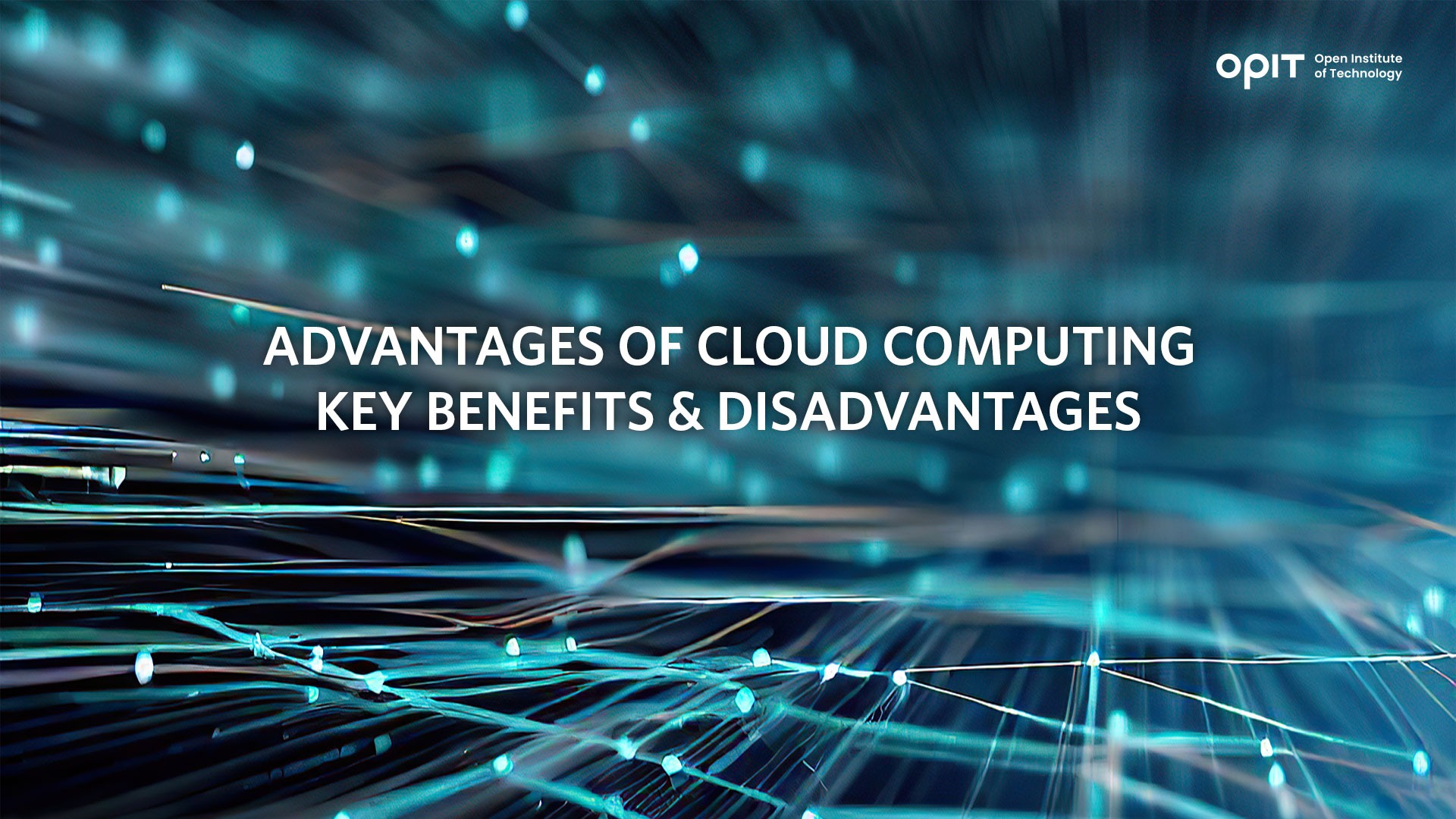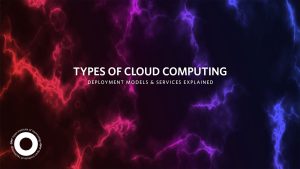

Gone are the days when you had to store boxes of documents in your office. Salvation came in the form of cloud computing in the 2000s. Since then, it’s made a world of difference for businesses across all industries, increasing productivity, organization, and decluttering the workspace. More importantly, it allows businesses to reduce various expenses by 30%-50%.
Cloud computing has countless benefits, but that doesn’t mean the technology is flawless. On the contrary, you should be aware of several disadvantages of cloud computing that can cause many problems with your implementation. Weighing up the pros and cons is essential – and we’ll do precisely that in this article.
Read on for the advantages and disadvantages of cloud computing.
Advantages of Cloud Computing
The cloud computing market is worth more than $540 billion. The main reason being that over 90% of all companies use some form of this technology. Here’s why they rely on cloud-based platforms.
Cost Efficiency
One of the greatest benefits of cloud computing is that it’s cost-efficient and allows you to reduce business expenses on three fronts.
Reduced Hardware and Software Expenses
You don’t need physical hardware to store your documents if you have a cloud computing platform. Likewise, the technology eliminates the need to run multiple software platforms because you can keep all your files in one place.
Lower Energy Consumption
In-house storage solutions can be convenient, but they consume a lot of electricity. Conversely, cloud computing systems help companies increase energy efficiency by over 90%.
Minimal Maintenance Costs
Maintaining such platforms is straightforward and affordable as cloud computing doesn’t involve heavy-duty software and hardware.
Scalability and Flexibility
Another reason cloud computing is popular is its scalability and flexibility. Here’s what underpins these advantages of cloud computing.
Easy Resource Allocation and Management
You don’t need to allocate your storage resources to numerous solutions if you have a unified cloud computing system. Managing your storage requirements becomes much easier with all your money going into one channel.
Pay-As-You-Go Pricing Model
Cloud-based platforms are available on a pay-as-you-go model. This reduces the risk of overpaying for your service because you’re only charged for the amount of data used.
Rapid Deployment of Applications and Services
Deploying cloud computing applications and services is simple. There’s no need for intense employee training, which further reduces your costs.
Accessibility and Mobility
Cloud computing is a highly accessible and mobile technology that can elevate your efficiency in a number of ways.
Access to Data and Applications From Anywhere
All it takes to access a cloud-based platform is a stable internet connection. As a result, you can retrieve key files virtually anywhere.
Improved Collaboration and Productivity
The ability to access data and applications from anywhere boosts collaboration and productivity. Your team gets a unified platform where they can share data with others much faster.
Support for Remote Work and Distributed Teams
Setting up a remote workspace is seamless with a cloud-computing solution. Employees no longer have to come to the office to perform repetitive tasks since they can do them from their computers.
Enhanced Security
If you want to address the most common security concerns in your organization, cloud computing is an excellent option.
Centralized Data Storage and Protection
By storing your information in a centralized location, you decrease the risk of data theft. In essence, you funnel all your resources into one platform rather than spread them out across multiple channels.
Regular Security Updates and Patches
Cloud computing providers offer regular updates to protect your information. Systems with the latest security patches are less prone to cyber attacks.
Advanced Encryption and Authentication Methods
You can also benefit from cloud computing tools due to their next-level encryption and authentication solutions. Most platforms feature AES 256-bit encryption, which is the most advanced and practically impregnable method. Furthermore, two-factor authentication lowers the chances of unauthorized access.
Disaster Recovery and Business Continuity
Business continuity and disaster recovery are two of the most pressing business challenges. Cloud computing solutions can help address these problems.
Automated Data Backup and Recovery
Many cloud storage systems are designed to automatically backup and recover your data. Hence, you don’t need to worry about losing your information in the event of a power outage.
Reduced Downtime and Data Loss
Since cloud computing helps prevent data loss, this technology also saves you less downtime. You don’t have to retrieve information manually because the platform does the work for you.
Simplified Disaster Recovery Planning
Although cloud computing tools are reliable, they’re not immune to failure caused by power loss, natural disasters, and other factors. Fortunately, these platforms have robust disaster recovery plans to get your system up and running in no time.
Disadvantages of Cloud Computing
Since the technology is so effective, you might be asking yourself: “Are there any disadvantages of cloud computing?” There are, and you need to understand these downsides to determine the best way to implement the technology. Here are the main drawbacks of cloud computing.
Data Privacy and Security Concerns
Like any other online technology, cloud computing can put users at risk of data privacy and security concerns.
Potential for Data Breaches and Unauthorized Access
While cloud apps have exceptional security practices, cyber criminals can bypass them with state-of-the-art technology and innovative hacking methods. Consequently, they may gain access to your information and steal your credentials.
Compliance With Data Protection Regulations
Your cloud computing tool may comply with many data protection regulations, but this doesn’t mean your information is 100% secure. Some standards only require apps to use robust password practices and fail to consider other attack methods, such as phishing.
Trusting Third-Party Providers With Sensitive Information
Online services require you to share your information to enable all features. Cloud computing is no different in this respect. You need to provide a third-party vendor with your data, which can be risky.
Limited Control and Customization
Cloud computing is a flexible and scalable technology. At the same time, it limits your control and customization options, which is why you might not be 100% happy with your platform.
Dependence on Cloud Service Providers
You decide what files you wish to share with your cloud-based solution. However, that’s pretty much it when it comes to the control you have over the platform. You depend on the vendor for every other aspect, including updates and patches.
Restrictions on Software and Hardware Customization
There aren’t many options to choose from when selecting a cloud storage plan. The price of your plan mostly depends on how much data you wish to share. Other than that, you get little-to-no hardware and software customization features.
Potential for Vendor Lock-In
Once you create an account with one cloud computing provider, you might not be happy with their services. As a result, you want to switch to a different platform. Many people think this is a simple transition, but that’s not always the case. Even though you can cancel your plan, migrating your data from one tool to the next can be difficult.
Network Dependency and Connectivity Issues
You might be relieved once you set up an account on a cloud-based platform: “I no longer need to clutter my office with masses of documents because I can now use an internet tool.” That said, using an online app also means you depend on network quality.
Reliance on Stable Internet Connection
A stable internet connection is essential for cloud computing. Internet problems can reduce or prevent you from accessing your files altogether.
Performance Issues Due to Network Latency
If your cloud network has high latency, sharing files can be challenging. In turn, latency reduces productivity and collaboration.
Vulnerability to Distributed Denial-of-Service (DDoS) Attacks
Cloud platforms are susceptible to so-called DDoS attacks. A cyber criminal can target your tool and keep you from accessing the service.
Downtime and Service Reliability
Not every cloud computing system performs the same in terms of reducing downtime and maximizing reliability.
Risk of Outages and Service Disruptions
While cloud-based solutions have exceptional recovery plans and backup methods, you’ll still face some downtime in case of outages. Even the shortest service disruption can cause major issues when working on certain projects.
Shared Resources and Potential for Performance Degradation
Cloud systems are convenient because they allow you to store your data in one place. Nonetheless, one of the key disadvantages of cloud computing is managing those shared resources. Accessing information can become difficult if you don’t stay on top of it.
Likewise, performance can drop at any point of your plan. App incompatibility and other issues can compromise data architecture and further compromise management.
Dependence on Provider’s Service Level Agreements (SLAs)
You’ll probably need to enter into an SLA when partnering with a cloud computing provider. These contracts can be rigid, meaning they may fail to recognize and adapt to evolving business needs.
Make an Informed Decision
Cloud computing has tremendous benefits, like improved data storage, collaboration, and cost reduction. The main drawbacks include hardware and software restrictions, connectivity issues, and potential downtime.
Therefore, you should understand the advantages and disadvantages of cloud computing before implementing a platform. Also, consider your business needs when partnering with a cloud provider to help prevent compatibility issues.
Related posts

Source:
- EFMD Global, Published on July 12th, 2024.
By Stephanie Mullins
Many people love to read the stories of successful business school graduates to see what they’ve achieved using the lessons, insights and connections from the programmes they’ve studied. We speak to one alumnus, Riccardo Ocleppo, who studied at top business schools including London Business School (LBS) and INSEAD, about the education institution called OPIT which he created after business school.
Please introduce yourself and your career to date.
I am the founder of OPIT — Open Institute of Technology, a fully accredited Higher Education Institution (HEI) under the European Qualification Framework (EQF) by the MFHEA Authority. OPIT also partners with WES (World Education Services), a trusted non-profit providing verified education credential assessments (ECA) in the US and Canada for foreign degrees and certificates.
Prior to founding OPIT, I established Docsity, a global community boasting 15 million registered university students worldwide and partnerships with over 250 Universities and Business Schools. My academic background includes an MSc in Electronics from Politecnico di Torino and an MSc in Management from London Business School.
Why did you decide to create OPIT Open Institute of Technology?
Higher education has a profound impact on people’s futures. Through quality higher education, people can aspire to a better and more fulfilling future.
The mission behind OPIT is to democratise access to high-quality higher education in the fields that will be in high demand in the coming decades: Computer Science, Artificial Intelligence, Data Science, Cybersecurity, and Digital Innovation.
Since launching my first company in the education field, I’ve engaged with countless students, partnered with hundreds of universities, and collaborated with professors and companies. Through these interactions, I’ve observed a gap between traditional university curricula and the skills demanded by today’s job market, particularly in Computer Science and Technology.
I founded OPIT to bridge this gap by modernising education, making it affordable, and enhancing the digital learning experience. By collaborating with international professors and forging solid relationships with global companies, we are creating a dynamic online community and developing high-quality digital learning content. This approach ensures our students benefit from a flexible, cutting-edge, and stress-free learning environment.
Why do you think an education in tech is relevant in today’s business landscape?

As depicted by the World Economic Forum’s “Future of Jobs 2023” report, the demand for skilled tech professionals remains (and will remain) robust across industries, driven by the critical role of advanced technologies in business success.
Today’s companies require individuals who can innovate and execute complex solutions. A degree in fields like computer science, cybersecurity, data science, digital business or AI equips graduates with essential skills to thrive in this dynamic industry.
According to the International Monetary Fund (IMF), the global tech talent shortage will exceed 85 million workers by 2030. The Korn Ferry Institute warns that this gap could result in hundreds of billions in lost revenue across the US, Europe, and Asia.
To address this challenge, OPIT aims to democratise access to technology education. Our competency-based and applied approach, coupled with a flexible online learning experience, empowers students to progress at their own pace, demonstrating their skills as they advance.
Read the full article below:

Source:
- The European, Summer 2024 Edition, Page 24
With careful planning, ethical considerations, and ensuring human oversight is maintained, AI can have huge market research benefits, says Lorenzo Livi of the Open Institute of Technology.
By Lorenzo Livi
To market well, you need to get something interesting in front of those who are interested. That takes a lot of thinking, a lot of work, and a whole bunch of research. But what if the bulk of that thinking, work and research could be done for you? What would that mean for marketing as an industry, and market research specifically?
With the recent explosion of AI onto the world stage, big changes are coming in the marketing industry. But will AI be able to do market research as successfully? Simply, the answer is yes. A big, fat, resounding yes. In fact, AI has the potential to revolutionise market research.
Ensuring that people have a clear understanding of what exactly AI is is crucial, given its seismic effect on our world. Common questions that even occur amongst people at the forefront of marketing, such as, “Who invented AI?” or, “Where is the main AI system located?” highlight a widespread misunderstanding about the nature of AI.
As for the notion of a central “main thing” running AI, it’s essential to clarify that AI systems exist in various forms and locations. AI algorithms and models can run on individual computers, servers, or even specialized hardware designed for AI processing, commonly referred to as AI chips. These systems can be distributed across multiple locations, including data centres, cloud platforms, and edge devices. They can also be used anywhere, so long as you have a compatible device and an internet connection.
While the concept of AI may seem abstract or mysterious to some, it’s important to approach it with a clear understanding of its principles and applications. By promoting education and awareness about AI, we can dispel misconceptions and facilitate meaningful conversations about its role in society.
Read the full article below:
- The European, Pages 24 to 26.
Have questions?
Visit our FAQ page or get in touch with us!
Write us at +39 335 576 0263
Get in touch at hello@opit.com
Talk to one of our Study Advisors
We are international
We can speak in:


